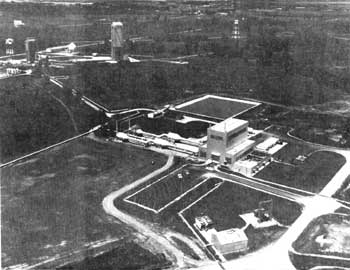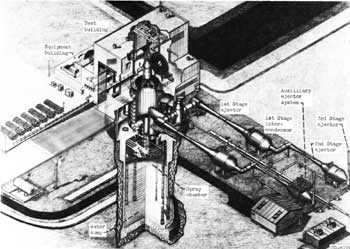.gif)
MENU
|
Man in Space
A National Historic Landmark Theme Study |

|
|
Rocket Engine Development Facilities |

Aerial view of Spacecraft Propulsion Research Facility, 1969.
(Courtesy of NASA, NASA/Lewis Research Center Facilities Office)
Spacecraft Propulsion Research Facility
| Name: | Spacecraft Propulsion Research Facility |
| Location: | Lewis Research Center Plum Brook Station, Sandusky, Ohio |
| Owner: | National Aeronautics and Space Administration (NASA) |
| Condition: | Excellent, unaltered, original location |
| Builder/Architect: | NASA |
| Dates: | 1968 |
DESCRIPTION
The Spacecraft Propulsion Research Facility is at the Plum Brook Station of the Lewis Research Center. This facility is designed for hot firings of full-size space vehicles in an environment simulating conditions at an orbital altitude of 100 miles. [1] The major elements that support this facility are a test building, an equipment building, a three stage exhaust system, a waste treatment retention pond, a propellant oxidizer and fuel storage area, an electrical substation, a refrigeration system and a service building.
The Spacecraft Propulsion Test Building is more than 70 feet high and extends 176 feet below grade. The below-grade spray chamber is 67 feet by 119 feet in diameter and holds 1,750,000 gallons of water. A 2.5-million-gallon retention pond is northeast of the test building. The three-stage steam ejectors are in the back of the test building and an 11 foot diameter duct connects them to the spray chamber. The vacuum test chamber is a stainless steel cylinder that can accommodate space vehicles up to 22 feet in diameter and 50 feet high. Two 6 foot 6 inch access openings are provided at the top and bottom of the test chamber. Five 8 inch viewports are provided at the top, center, and bottom of the test chamber for TV monitors. The test chamber is provided with a 27 foot access door for test spacecraft articles. The heat sink of space is simulated by a Liquid Hydrogen cold wall (maintained at -320°F) consisting of copper tube-in-strip panels surrounding the inside wall and top dome of the test chamber. Twelve columns of quartz infrared lamps spaced along an arc of the inside wall of the test chamber simulate thermal radiation and heat from the sun .
In operation, an entire vehicle can be vacuum "soaked" to the proper environmental space conditions in p reparation for engine test firing. With the -320°F cold walls and 5 X 10-8-torr vacuum, rocket engines can be ignited in the chamber under space conditions. As chamber pressure builds up because of the exhaust gas, an 11 inch diameter valve opens in 0.4-second to connect the chamber to a steam ejector system. Two parallel steam ejectors remove the engine exhaust products from the chamber while maintaining a moderate vacuum level. Three large dump tanks are in the exhaust spray chamber to receive propellants in an emergency situation.
The exhaust system includes a 250,000-gallon-per-minute water spray system for cooling the rocket exhaust. The spray system water is recirculated through the 1.75-million-gallon catch basin under the chamber.
STATEMENT OF SIGNIFICANCE
The Spacecraft Propulsion Research Facility's significance rests in its association with the development of the Centaur Rocket. This facility is the only one in NASA's inventory that can hot fire a large rocket while simulating the vacuum, cryogenic temperatures, and thermal radiation of space. The duplication of this space environment was crucial to the development of the Centaur Rocket which was designed to fire from Earth Orbit to send vehicles to explore the planets and Solar System. The Centaur upper stage rocket has launched some of America's most important space probes including the Pioneer, Viking and Voyager Spacecraft. The successful development and use of the Centaur was due in large measure to data that was collected from successful test firings of Centaur engines in this facility.
The importance of the Spacecraft Propulsion Research Facility is in its unique technical capabilities and its association with the Centaur research and development program. At the present time this facility is maintained by NASA on a standby status.
FOOTNOTES
1. Information taken for the description of the Spacecraft Propulsion Research Facility was derived from the following sources:
Plum Brook Station (Cleveland, Ohio: Lewis Research Center, No Date), p.16.
Spacecraft Propulsion Research Facility "B-2" (Cleveland, Ohio: Lewis Research Center, May 1972), pp. 1-17.
Technical Facilities Catalogue Vol. I (Washington, D.C.: National Aeronautics and Space Administration, 1974), pp. 4-89., 4-90.
BIBLIOGRAPHY
Plum Brook Station. Cleveland, Ohio: Lewis Research Center, No date.
Spacecraft Propulsion Research Facility "B-2". Cleveland, Ohio: Lewis Research Center, 1972.
Technical Facilities Catalog Vol. I. Washington, D.C.: National Aeronautics and Space Administration, 1974.
PHOTOGRAPHS

Cutaway view of the facility, 1981.
(Courtesy of NASA, NASA/Lewis Research Center Facilities Office)
 Top
Top
Last Modified: Mon, Jan 8 2001 10:00:00 am PDT
http://www.cr.nps.gov/history/online_books/butowsky4/space7.htm
![]()
